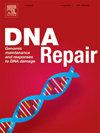DNA损伤反应抑制剂在癌症治疗中的应用:机制、临床发展和联合策略
IF 2.7
3区 生物学
Q2 GENETICS & HEREDITY
引用次数: 0
摘要
基因组稳定性受损是许多癌症的标志,DNA损伤反应(DDR)机制是维持基因组完整性的关键保障。这些复杂的DDR网络包含各种DNA修复和损伤检查点通路,对调节细胞周期、免疫反应和细胞凋亡至关重要。值得注意的是,DDR通路中的缺陷,特别是那些涉及BRCA1/2突变的缺陷,为PARP抑制剂(PARPi)等靶向治疗提供了可利用的漏洞。这篇综述探讨了PARPi作为癌症治疗的机制,重点是它们抑制DNA修复过程和诱导肿瘤细胞死亡的能力。它还检查了PARPi临床试验的现状及其在各种癌症类型中的应用。此外,我们还讨论了新兴的DDR抑制剂,包括CHK1/2、ATR、ATM、RAD51、APE1和WEE1,其中许多抑制剂通过抑制DNA修复和损伤检查点起作用。这些抑制剂选择性地靶向检查点功能缺陷的恶性细胞,从而诱导复制应激和有丝分裂灾难。虽然DDR抑制剂作为单独治疗或与化疗、免疫治疗和放射联合治疗具有巨大潜力,但挑战仍然存在,包括重叠毒性和对健康组织的损害。本综述旨在阐明快速发展的基于ddr的靶向癌症治疗领域,强调其革命性治疗方法和改善患者预后的潜力。本文章由计算机程序翻译,如有差异,请以英文原文为准。
DNA damage response inhibitors in cancer therapy: Mechanisms, clinical development, and combination strategies
Impaired genomic stability is a hallmark of many cancers, with the DNA damage response (DDR) mechanisms serving as critical safeguards for maintaining genomic integrity. These intricate DDR networks, encompassing various DNA repair and damage checkpoint pathways, are essential for regulating the cell cycle, immune responses, and apoptosis. Notably, defects in DDR pathways, particularly those involving BRCA1/2 mutations, present exploitable vulnerabilities for targeted therapies such as PARP inhibitors (PARPi). This review explores the mechanisms by which PARPi function as cancer therapies, focusing on their ability to inhibit DNA repair processes and induce tumor cell death. It also examines the current landscape of PARPi clinical trials and their application across various cancer types. In addition, we discuss emerging DDR inhibitors, including CHK1/2, ATR, ATM, RAD51, APE1, and WEE1, many of which act by inhibiting DNA repair and damage checkpoints. These inhibitors selectively target malignant cells that are deficient in checkpoint function, thereby inducing replication stress and mitotic catastrophe. While DDR inhibitors hold great potential as standalone therapies or in combination with chemotherapy, immunotherapy, and radiation, challenges persist, including overlapping toxicities and damage to healthy tissues. This review aims to illuminate the rapidly advancing field of DDR-based targeted cancer therapies, emphasizing their potential to revolutionize treatment approaches and improve patient outcomes.
求助全文
通过发布文献求助,成功后即可免费获取论文全文。
去求助
来源期刊

DNA Repair
生物-毒理学
CiteScore
7.60
自引率
5.30%
发文量
91
审稿时长
59 days
期刊介绍:
DNA Repair provides a forum for the comprehensive coverage of DNA repair and cellular responses to DNA damage. The journal publishes original observations on genetic, cellular, biochemical, structural and molecular aspects of DNA repair, mutagenesis, cell cycle regulation, apoptosis and other biological responses in cells exposed to genomic insult, as well as their relationship to human disease.
DNA Repair publishes full-length research articles, brief reports on research, and reviews. The journal welcomes articles describing databases, methods and new technologies supporting research on DNA repair and responses to DNA damage. Letters to the Editor, hot topics and classics in DNA repair, historical reflections, book reviews and meeting reports also will be considered for publication.
 求助内容:
求助内容: 应助结果提醒方式:
应助结果提醒方式:


